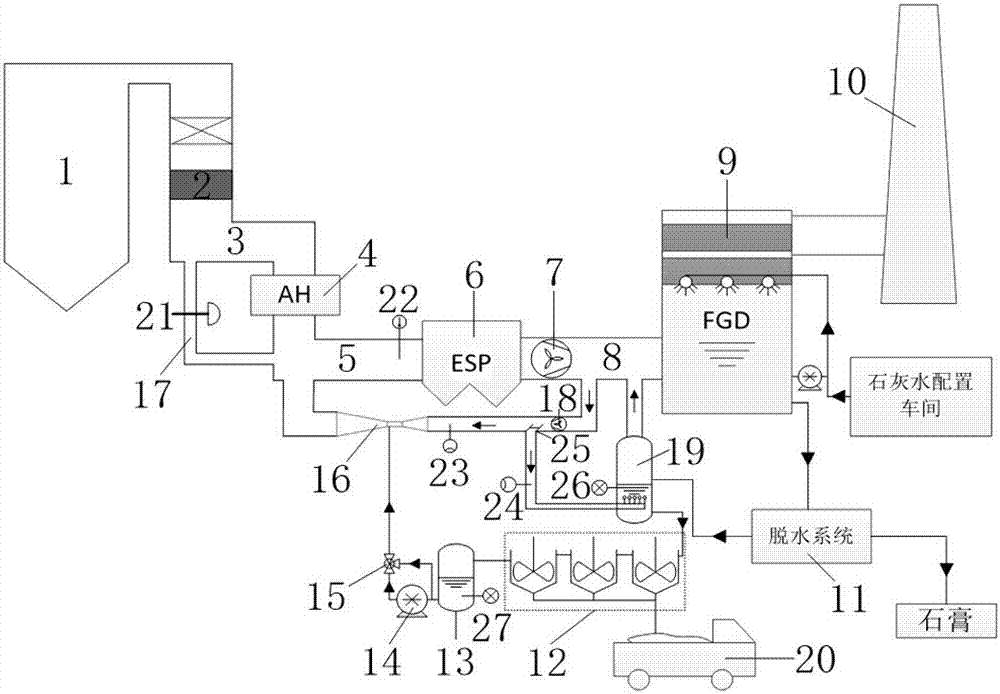However, the desulfurization wastewater is the terminal wastewater of the power
plant, which is affected by many factors, and it is greatly affected by the working conditions and
coal types; the pH is between 4.5-6.5, it is weakly acidic, and the content of
chloride ions is high; the
gypsum particles,
silicon dioxide, iron The content of
suspended solids with aluminum compounds as the main component is high, which may easily cause
fouling of the membrane
filtration device; the content of
total dissolved solids is high, and the range of variation is large, generally 30000-60000 mg / L, and the content of
hardness ions such as Ca2+ and Mg2+ is high , Mercury, lead,
arsenic and other heavy
metal pollutants exceed the standard
The traditional physical and chemical desulfurization wastewater treatment methods commonly used at present can only remove most of the heavy
metal ions, but cannot remove the highly mobile
chloride ions
[0003] Aiming at the status quo of desulfurization wastewater with complex
water quality and its difficulty in treatment, the
Chinese patent No. 201710054360.3 discloses a wastewater concentration
system and method based on
liquid column evaporation using
flue gas waste heat. The desulfurization wastewater is sprayed into the In the
evaporation tower, the waste heat of the flue gas in front of the desulfurization tower is used to concentrate the desulfurization wastewater. A
demister is arranged at the outlet of the evaporation tower to remove the liquid droplets in the flue gas. The purpose of desulfurization wastewater concentration reduction, but this method increases the
corrosion of the existing flue; the
Chinese patent No. 201010179796.3 discloses a thermal power
plant wet
flue gas desulfurization wastewater spray evaporation treatment method, the desulfurization wastewater is directly in the power plant Spray evaporation in the flue before the
dust collector to achieve zero
discharge of desulfurization wastewater, but this method directly sprays the desulfurization wastewater without
reduction treatment into the main flue before the
electrostatic precipitator, which increases the
corrosion risk of the
electrostatic precipitator; the patent number is The
Chinese patent of 201510275955.2 discloses a zero-
discharge process and system for desulfurization wastewater. It uses chemical
softening and
microfiltration membrane for pretreatment, adopts
nanofiltration and
reverse osmosis separation, freezes and crystallizes
sodium sulfate decahydrate with a purity of more than 99%, evaporates
Crystallization of
sodium chloride with a purity of 98% also provides a zero-discharge system that can reuse desulfurization wastewater, but the system is lengthy, the
processing steps are cumbersome, and the investment and operating costs are high; the Chinese patent No. 201611008084.9 discloses A system and method for the comprehensive treatment of desulfurization wastewater concentration and flue gas
drying. After the desulfurization wastewater is treated by a traditional triple box, it is concentrated by an
evaporator. The concentrated wastewater is evaporated and crystallized by the heat of the flue gas in the bypass flue, and the air flows through the dust removal. Then it is discharged from the
chimney, but this method directly uses the high-temperature flue gas in front of the
air preheater to evaporate the desulfurization wastewater, and the subsequent
solid evaporated product is collected by a
cyclone dust collector instead of being captured by an
electrostatic precipitator and mixed into the
fly ash. It not only increases the
energy consumption of desulfurization wastewater evaporation, but also its
solid evaporated product needs to be treated as hazardous solid waste due to the enrichment of
heavy metals and other pollutants
The Chinese patent No. 201610031262.3 discloses a method and device for treating desulfurization wastewater by using flue gas waste heat. The desulfurization wastewater discharged from the
slurry dehydration system is directly sprayed into the concentration system transformed from the main flue before the wet desulfurization absorption tower. In this method, the
effluent from the concentration system is directly sent to the main flue in front of the electrostatic precipitator for atomization and evaporation. However, the desulfurization wastewater in this method is not treated by three-box dosing. There are more
calcium,
magnesium and heavy
metal ions in the water, and the
water quality is poor. Not only Increase the risk of
corrosion and
fouling of the main flue before the electrostatic precipitator, and increase the risk of clogging of the mechanical atomization or medium atomization method used
[0004] Treating desulfurization wastewater by evaporation and
crystallization, in order to achieve higher salt separation requirements, often requires
high energy consumption and high economic costs; compared with flue evaporation, on the one hand, the bypass evaporation tower brings relatively high costs to the power plant. Large investment, on the other hand, brings pressure on
land use for power plants that occupy a tight area for their equipment
However, the low treatment capacity of desulfurization wastewater in flue evaporation and the inability to completely evaporate
dryness under
low load limit the development of flue evaporation technology for desulfurization wastewater. 90~120℃) for reduction and concentration, and then use the waste heat of the flue gas before electrostatic precipitator (about 120℃) for atomization and evaporation to
dryness. The
cascade utilization of the waste heat of the flue gas in the power plant realizes desulfurization while reducing the investment of the power plant Zero discharge of waste water
 Login to View More
Login to View More  Login to View More
Login to View More 

